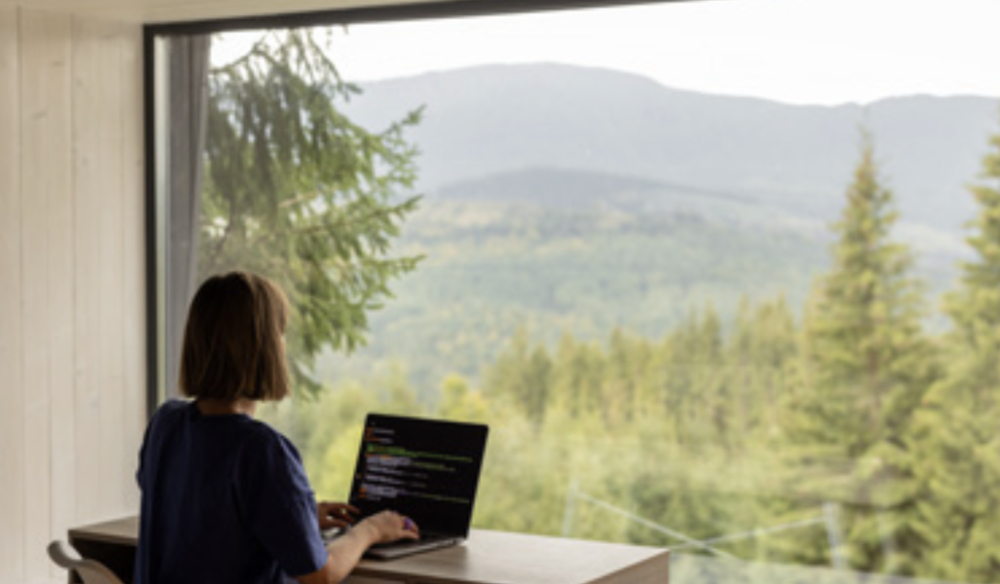Biophilic design and natural light

|
| Text and images supplied by Paul Trace, Stella Rooflight for AT Journal issue 148, Winter 2023. |
Contents |
[edit] Biophilic design: embracing nature’s light
In an era marked by technological advancements and urbanisation, the longing for a connection with nature has never been stronger. Biophilic design, a concept rooted in the idea of incorporating natural elements into built environments, offers a promising solution to bridge this gap. One key element of biophilic design that holds immense potential for enhancing wellbeing, health and productivity is natural daylight. As the trend of home working gains popularity, the significance of natural daylight in home design becomes even more pronounced.
[edit] The rise of biophilic design
Biophilic design is an innovative approach that draws inspiration from nature and aims to create spaces that foster a sense of harmony and balance between the built environment and the natural world. This design philosophy recognises the innate human inclination to connect with nature and seeks to harness its benefits for individuals’ physical, emotional and mental well-being. The notion that access to green outdoor spaces and naturally bright indoor environments, improves wellbeing and productivity is not a new concept. During the 19th Century industrial era, wealthy factory and mill owners would create parks to ensure their workforce had access to clean fresh air and places to relax when not working. This idea has evolved into the post-industrial age: today, this relationship between humans and nature, and understanding of the essential human need to connect to a natural environment in the workplace is being taken increasingly seriously by designers, developers and house builders, and is described by the phrase ‘biophilic design’ or ‘biophilia’ – the practice of incorporating nature into the built environment.
[edit] The influence of natural daylight
Among the various biophilic design elements, natural daylight is arguably one of the most influential. The introduction of natural light into a living or working space has far-reaching effects on occupants’ overall health, productivity, and mood. Researchers have found several compelling reasons to prioritise natural daylight in home design:
[edit] Improved wellbeing
Improved wellbeing: Exposure to natural light has been linked to enhanced mood and reduced feelings of stress and anxiety. Sunlight triggers the release of serotonin in the brain, which contributes to feelings of happiness and well-being. Homes that receive ample natural daylight offer a healthier and more uplifting environment for their inhabitants.
[edit] Enhanced health
Enhanced health: Natural daylight exposure plays a crucial role in regulating the body’s circadian rhythm, which governs our sleep-wake cycle. A well-regulated circadian rhythm is associated with better sleep quality, increased energy levels, and improved immune function. By incorporating natural daylight into home design, occupants can enjoy a more balanced and healthier lifestyle.
[edit] Boosted productivity
Boosted productivity: For individuals working from home, the impact of natural daylight on productivity cannot be underestimated. Research indicates that exposure to daylight in workspaces can result in higher productivity levels, increased focus, and reduced instances of eye strain and headaches. A well-lit home office that embraces natural light can create a more conducive environment for efficient and creative work.
[edit] The rise of home working
The concept of working from home has undergone a seismic shift in recent years. The global pandemic significantly accelerated this trend, compelling countless individuals to transform their living spaces into productive work environments. With home offices becoming more common, the importance of optimising these spaces for health and productivity has never been greater. Designing home workspaces with natural daylight Integrating natural daylight into home workspaces requires thoughtful planning and design. Here are some practical tips for maximising the benefits of natural light in your home office:
[edit] Workspace positioning
Positioning: Choose a workspace that allows ample natural light to flow in throughout the day. Position your desk near the brightest part of the room to make the most of the available daylight.
[edit] Workspace solar control
Solar control: Opt for glazing treatments, such as solar controlled glass, that control the amount of sunlight entering the room. This way, you can avoid glare on screens while still enjoying the benefits of natural light.
[edit] Reflective work surfaces
Reflective surfaces: Incorporate reflective surfaces, such as light-coloured walls and furniture, to help distribute and amplify natural light within the workspace.
[edit] Adding biophilic elements
Biophilic elements: In addition to natural light, consider adding other biophilic elements to your home office, such as indoor plants and natural materials. These elements further enhance the connection to nature and promote a calming and inspiring atmosphere.
[edit] The role of the rooflight
Rooflights can help to provide natural light with qualities appropriate to the use of the building. Rooflights let in light from the brightest part of the sky and are not generally affected by external obstructions, such as trees or other buildings. They also provide a more even pattern of light than vertical windows.
Rooflights can form part of an effective technical lighting scheme, particularly in conjunction with efficiently controlled artificial lighting, to produce specified illumination levels for particular tasks. According to leading consultants, horizontal rooflights provide three times more light than vertical windows (the equivalent of 10,000 candles on a sunny day), which is more than 200 times the light needed for most educational or work- related tasks.
In addition, rooflights can also add to the more subjective qualities of spaces as an integral part of the building’s architecture. They can provide views of the sky and promote a sense of well-being and connection with the outside without the distractions encountered with views through vertical glass windows. These facts are well understood by most people involved in building design. However, the huge potential of rooflights to provide exactly the amount, type and distribution of natural light required to meet any given specification is not always appreciated.
[edit] Conclusion
As our lives become increasingly urbanised and technology-driven, biophilic design emerges as a powerful tool to reintegrate nature into our built environments. Natural daylight, a fundamental aspect of biophilic design, has a profound impact on wellbeing, health and productivity.
For those embracing the trend of home working, the incorporation of natural daylight into home design is an essential step towards creating a nurturing and productive workspace. By prioritising the inclusion of natural light via rooflights, we can foster a more balanced and harmonious living environment that promotes our overall happiness and performance.
This article appears in the AT Journal issue 148, Winter 2023 text and images supplied by Paul Trace, Stella Rooflight.
--CIAT
[edit] Related articles on Designing Buildings
- Architectonics.
- Architectural styles.
- Bedzed.
- Biodiversity
- Biodiversity net gain and related terminologies explained.
- Biogenic carbon.
- Biologic carbon sequestration.
- Biomass.
- Carbon cycle.
- English architectural stylistic periods.
- Sustainability in building design and construction.
- The architectural profession.
- The sustainability of construction works.
- Traditional building.
- Types of rapidly renewable content
- Natural materials
- Nature and buildings; terms, histories, theories and practice.
- Urban design.
- What is design?
Featured articles and news
Gregor Harvie argues that AI is state-sanctioned theft of IP.
Many resources for visitors aswell as new features for members.
Using technology to empower communities
The Community data platform; capturing the DNA of a place and fostering participation, for better design.
Heat pump and wind turbine sound calculations for PDRs
MCS publish updated sound calculation standards for permitted development installations.
Homes England creates largest housing-led site in the North
Successful, 34 hectare land acquisition with the residential allocation now completed.
Scottish apprenticeship training proposals
General support although better accountability and transparency is sought.
The history of building regulations
A story of belated action in response to crisis.
Moisture, fire safety and emerging trends in living walls
How wet is your wall?
Current policy explained and newly published consultation by the UK and Welsh Governments.
British architecture 1919–39. Book review.
Conservation of listed prefabs in Moseley.
Energy industry calls for urgent reform.
Heritage staff wellbeing at work survey.
A five minute introduction.
50th Golden anniversary ECA Edmundson apprentice award
Showcasing the very best electrotechnical and engineering services for half a century.
Welsh government consults on HRBs and reg changes
Seeking feedback on a new regulatory regime and a broad range of issues.
CIOB Client Guide (2nd edition) March 2025
Free download covering statutory dutyholder roles under the Building Safety Act and much more.


























